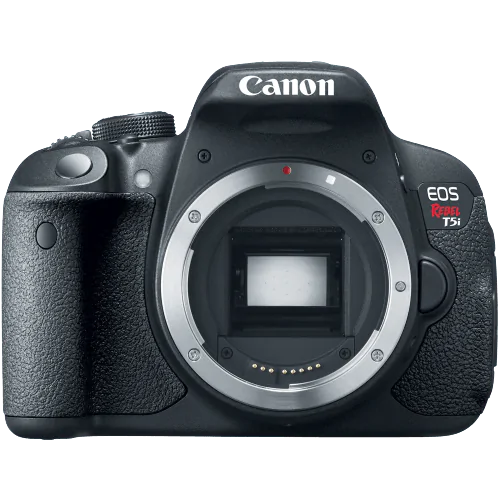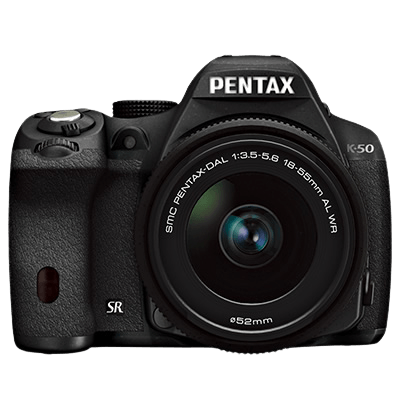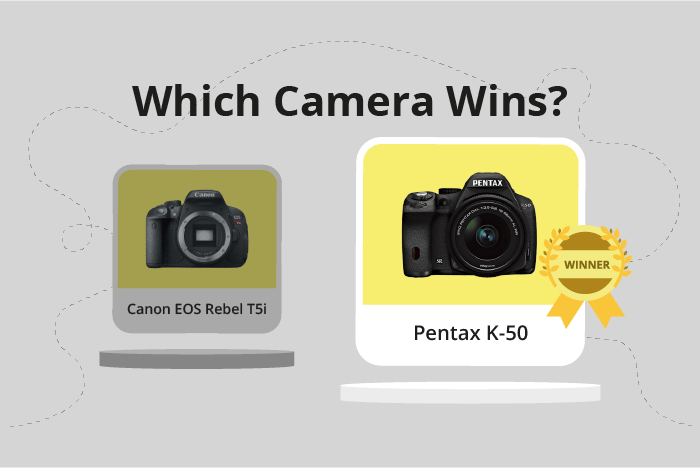Canon EOS Rebel T5i / 700D vs Pentax K-50 Comparison
Canon EOS Rebel T5i / 700D

Pentax K-50

The Pentax K-50 emerges as the winner in our comparison, scoring 57/100, while the Canon EOS Rebel T5i / 700D trails behind with a score of 44/100. Both cameras are DSLRs released in 2013, with the Canon T5i priced at $750 and the Pentax K-50 at $599. They share similar dimensions, with the Canon T5i measuring 133 x 100 x 79mm and the Pentax K-50 measuring 130 x 97 x 71mm. The Canon T5i is lighter, weighing 580g / 1.28lbs, compared to the Pentax K-50 at 650g / 1.43lbs.
The Pentax K-50 outperforms the Canon T5i in several aspects, contributing to its higher score. On the other hand, the Canon T5i holds an advantage in terms of weight, being lighter than the Pentax K-50. Despite its higher price, the Canon T5i’s lower score indicates that it may not offer the best value for money compared to the Pentax K-50.
In the end, the Pentax K-50 proves to be a better camera with a higher score and more competitive pricing, while the Canon T5i offers a lighter option for those prioritizing weight.
Canon EOS Rebel T5i / 700D vs Pentax K-50 Overview and Optics
The Pentax K-50 wins in the optics comparison with a score of 62/100, while the Canon EOS Rebel T5i / 700D scores 40/100. Both cameras have an APS-C CMOS sensor, which is common in this category of cameras. They also share similar lens mounts, with the Canon using an EF-S mount and the Pentax using a KAF mount.
The Pentax K-50 excels in several aspects. Its DXOMARK sensor score of 79 is higher than the Canon’s 61, indicating better overall image quality. The K-50 also has a faster shooting speed of 6 frames per second, compared to the Canon’s 5 frames per second. Additionally, the K-50 offers built-in image stabilization, which the Canon lacks.
On the other hand, the Canon EOS Rebel T5i / 700D has a higher megapixel count at 18, compared to the Pentax’s 16.28. This may result in slightly higher resolution images. However, the difference in megapixels is not significant enough to outweigh the other advantages of the Pentax K-50.
In terms of optics, the Pentax K-50 is the superior camera. Its higher DXOMARK sensor score, faster shooting speed, and image stabilization make it a better choice for photographers seeking better image quality and performance. While the Canon EOS Rebel T5i / 700D has a slightly higher megapixel count, it falls short in other key aspects, making the Pentax K-50 the clear winner in this comparison.
Canon EOS Rebel T5i / 700D vs Pentax K-50 Video Performance
The Pentax K-50 emerges as the winner in the video capabilities comparison, scoring 57/100, while the Canon EOS Rebel T5i / 700D scores 43/100. Both cameras share some common specifications, such as Full HD video resolution with maximum dimensions of 1920 x 1080 and a maximum video frame rate of 30fps.
The Pentax K-50 outperforms the Canon EOS Rebel T5i / 700D in one significant aspect: it has built-in time-lapse functionality. This feature enables users to capture stunning time-lapse videos, which is an advantage for those who enjoy creating dynamic and visually appealing content. On the other hand, the Canon EOS Rebel T5i / 700D lacks this feature, limiting its versatility in video creation.
While the Canon EOS Rebel T5i / 700D falls short in comparison to the Pentax K-50, it still offers decent video capabilities with its Full HD resolution and 30fps frame rate. These specifications are sufficient for casual users who wish to capture high-quality videos without the need for advanced features.
Taking these points into account, the Pentax K-50 stands out as the superior choice for video capabilities due to its built-in time-lapse functionality. This feature sets it apart from the Canon EOS Rebel T5i / 700D, making it a more versatile option for users who want to explore creative video techniques. Meanwhile, the Canon EOS Rebel T5i / 700D remains a suitable option for those content with standard video features and not requiring time-lapse functionality.
Canon EOS Rebel T5i / 700D vs Pentax K-50 Features and Benefits
The Canon EOS Rebel T5i / 700D wins the features comparison with a score of 57/100, while the Pentax K-50 scores 54/100. Both cameras share several specifications, including a 3-inch screen size, and the absence of GPS, Wi-Fi, and Bluetooth connectivity.
The Canon T5i / 700D stands out with a higher screen resolution of 1,040,000 dots, compared to the Pentax K-50’s 921,000 dots. This difference provides the T5i / 700D with a clearer and more detailed display. Additionally, the T5i / 700D has a touchscreen, making it more user-friendly and easier to navigate through settings and options. The T5i / 700D also features a flip screen, which is beneficial for capturing images and videos from various angles and perspectives.
On the other hand, the Pentax K-50 does not offer any significant advantages over the Canon T5i / 700D in terms of features. Both cameras lack GPS, Wi-Fi, and Bluetooth, making them equal in terms of connectivity. The K-50’s lower feature score reflects its fewer advantages compared to the T5i / 700D.
Considering the differences in feature scores and the advantages offered by the Canon T5i / 700D, it is clear that this camera is the better option for those prioritizing features. The higher screen resolution, touchscreen, and flip screen provide a more enjoyable and versatile user experience. The Pentax K-50, while still a decent camera, falls short in these areas, making the Canon T5i / 700D the superior choice based on features.
Canon EOS Rebel T5i / 700D vs Pentax K-50 Storage and Battery
The Canon EOS Rebel T5i / 700D and the Pentax K-50 both receive a storage and battery score of 24/100. These cameras share common specifications such as having one memory card slot each and accepting SD, SDHC, and SDXC memory cards. Neither camera offers USB charging.
The Canon EOS Rebel T5i / 700D outperforms the Pentax K-50 in battery life, providing 440 shots compared to the K-50’s 410 shots. This difference makes the Canon T5i / 700D slightly better in terms of battery performance, thanks to its LP-E8 battery type.
However, the Pentax K-50 does not surpass the Canon T5i / 700D in any storage or battery-related aspect, as both cameras have the same score and similar specifications.
Considering these points, the Canon T5i / 700D has a minor advantage in battery life, while both cameras remain on par in terms of storage capabilities. This information can be useful for potential buyers to make an informed decision based on their preferences and requirements.
Alternatives to the Canon EOS Rebel T5i / 700D and Pentax K-50
Are you still undecided about which camera is right for you? Have a look at these popular comparisons that feature the Canon EOS Rebel T5i / 700D or the Pentax K-50:

